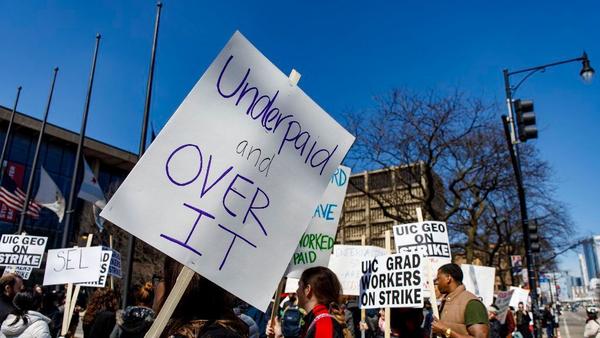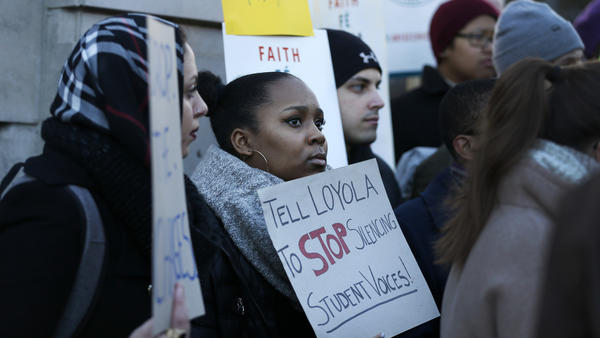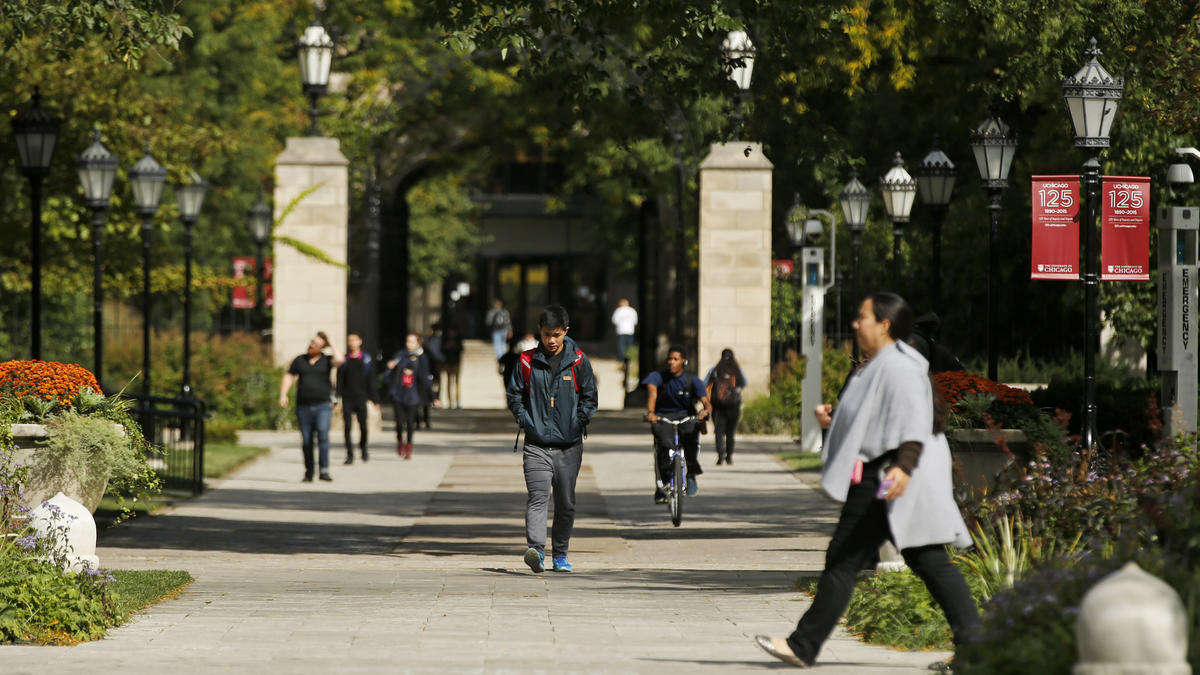Last month, Graduate Students United, the union representing grad students at the University of Chicago, announced that its members had voted to authorize a strike. The action, which begins today, is the latest in a years-long campaign by grad students at U. of C., which relies heavily on grad students for teaching, grading, and other TA work in undergraduate courses, in exchange for a stipend starting at $27,000 a year.
The strike is part of a larger trend among grad unions in Chicago this spring, which coincides with a National Labor Relations Board decision to revisit a ruling that allows grad students to unionize. Now, mired in uncertain legal standing and weary of non-cooperative school leadership, students have engaged in more aggressive action in an attempt to have their demands met.
Earlier this spring at the University of Illinois at Chicago, a three-week strike forced the administration to accede to most student demands. Meanwhile, at Loyola, pro-union protesters were arrested during a downtown demonstration in April.
Now it's U. of C. where one of higher ed’s most contentious fights will escalate, with finals week and graduation right around the corner.
GSU organizers say that the school recognizing their union would allow grad students to work under a formal contract. Currently, grad students are covered by the terms of their acceptance to the university, or the offer letters given at the beginning of the academic year.
But since those aren't official contracts, they're not legally enforceable, and grad students say the terms of their enrollment can change unexpectedly.
“We have acceptance emails, but they’re terrible contracts,” says Andrew Kunze, a GSU representative and PhD student in the Divinity School. “The expectations that are placed upon us for our degree requirements change depending on our administrators and our position. We need standardization and codification of job expectations.”
According GSU's own survey, administered last year, most grad students experience various forms of economic insecurity. Twenty-five percent say they spend more than half their income from the university on housing, and two-thirds don’t have dental insurance.
But GSU’s attempts to unionize have been met with resistance by U. of C., which claims that undergraduates' “successful completion of this academic quarter” could be affected by the strike, according to spokesperson Jeremy Manier.
On Thursday, John Boyer, the dean of the college, sent an email to undergraduates and their parents encouraging students to report no-show instructors to their college advisors.
In another email Friday, the dean of the Physical Sciences Division, Angela Olinto, requested that lab heads report any graduate assistants supported through external grants who worked reduced hours during the strike, noting that lost hours must be deducted from grant funds. She added that “student effort be tracked only to ensure compliance with grant requirements.”

A ruling, a reversal, then a re-reversal by the NLRB
Unlike at public universities, where unions have been the norm since the '90s, private universities and graduate students have fought for decades over whether teaching assistants are employees.
In 2004, the National Labor Relations Board reversed a previous decision and ruled that Brown University grad students were not workers, since they had a “primarily educational, not economic, relationship with the university.” Brown’s provost at the time, Robert J. Zimmer, commended the NLRB for its decision. Zimmer is now president of the U. of C.
However, in August 2016, the NLRB reversed its reversal, declaring that teaching and research assistants at private universities should be allowed to collectively bargain with administrations. That set off a wave of organizing efforts at schools across the country. Soon, grad students at Yale, Columbia, and Tufts had formed unions.
At the U. of C., grad students voted by a 70–30 margin to unionize in October 2017. In a message announcing the results of the election, the office of the provost noted that it was asking the NLRB to “revisit” the results of its recent decision, ostensibly hoping that a Trump-appointed NLRB would be less forgiving of unions.
In February 2018, faced with the prospect of a hearing before that unfriendly board, GSU members voted to withdraw their case from the NLRB. Instead, the group asked the U. of C. to voluntarily recognize them.
Then, last month, GSU and other grad student unions received the bad news they'd been expecting: The NLRB announced that it would issue a new rule on grad unions sometime this fall.
“There’s a lot of talk about their announcement,” says Emily Smith, GSU’s general secretary and a PhD student in the department of Near Eastern Languages and Civilizations. “At the moment, it doesn't change anything. We’ve been democratically elected … We just want the administration to recognize us as such and say they’ll work with us in the future.”
Since the beginning of the school year, GSU organizers have led a series of actions to put pressure on the school, including a walk-out, a work-in at the campus library, and a May Day protest with other labor groups on campus.
Starting today, students will begin picketing; Smith says the strike's duration will be up to GSU members.
But organizers are also quick to note that the onus is on the administration.
“It costs them nothing," says Kunze. "They can recognize us with an email."
Unions vs. the U. of C.: A Brief History
The U. of C. has a long and often antagonistic history with organized labor. In 1898, the university’s then-president, William Rainey Harper, was voted chairman of a commission formed by Mayor Carter Harrison to suggest reforms to Chicago’s public school system. The Harper Commission’s report, issued the following year, recommended that most of the duties of the school board, then 21 people, be transferred to the superintendent. It also worried that there were too many female teachers; at one point, the commission suggested incentivizing male hires by offering them higher wages.
The nascent Chicago Federation of Teachers, ancestor of the Chicago Teachers Union, strongly opposed the Harper Commission’s conclusions. As historian Steven J. Diner writes in his book A City and Its Universities: Public Policy in Chicago, 1892–1919, they worried that it represented “a deliberate attempt by the University of Chicago, aligned with the business interests, to dominate the public schools.”
Led by organizer Margaret Haley, the union won its first big political fight, defeating legislation based on the report. (In the long run, however, Diner notes that most of the recommendations were adopted into law.)
In more recent years, the university has unsuccessfully fought a unionization effort by its library workers, and has a complex relationship with Faculty Forward, the union representing non–tenure track faculty. It's also levied budget cuts that that student organizers and faculty members say hurt low and mid-level workers.
Defying the NLRB
Alec Stubbs, a grad student organizer at Loyola, says that the possibility of another NLRB reversal won’t change much in the battle between higher ed and student unions. At Loyola, grad students have been asking the university to recognize their union since February 2017. They were one of the first schools to vote for unionization after the 2016 NLRB case.
Initially, administrators told students they would bargain with them. But half a year later, the school switched its stance, reverting to the standard line used by most private universities: because grad students are “fundamentally” students, they don’t count as employees. As a result, Loyola’s grad union finds itself in the same legal limbo as GSU.
“We’ve had to engage in direct action, because [Loyola] is taking the line that we are not employees,” says Stubbs. “If the [NLRB] ruling does come down that way, it really won’t change the way we operate.”

Despite the arrests at their downtown demonstration, Loyola graduate students aren’t striking. And while Stubbs concedes that their focus on direct action is partly due to the NLRB decision, he says it’s also connected to most grad students' precarious position after the Great Recession.
“Living in a post-2008 world, a lot of grad workers are facing tens of thousands of dollars in student loan debt. You’re seeing these movements not only because grad worker stipends don’t lead to a sustainable lifestyle, but because the labor movement is getting stronger.”
In UIC's case, a three-week strike, led by the Graduate Employees Organization, caused hundreds of classes to be canceled. The strike, GEO organizers say, was due to administrators' unwillingness to bargain over a number of issues, most importantly proposed fee increases for students — both the general fee applied to all students, which supports the fixed cost of campus housing and facilities, and additional fees specific to international students.
“Any time we gave them any sort of proposal on fee relief, they told us it wasn’t possible,” says Erin O’Callaghan, GEO co-president. “[It wasn’t until] we went on strike they realized it was a fundamental thing we needed.”
In UIC's final contract, fee increases were offset by a bump in pay for grad students. Any future hikes will be negotiated by GEO.
UIC, like the University of Chicago and Loyola, seems to have shifted its approach toward unions in light of changes to the law. Last June, in Janus v. AFSCME, the Supreme Court held that public-sector workers didn’t have to pay union dues. The former president of GEO, Jeff Schuhrke, claimed last fall in Jacobin that after the Janus decision, UIC’s administration failed to automatically deduct dues from the paychecks of union members on campus. More generally, he charged the administration with thinking that it could now “ride roughshod over us and impose terrible contracts.”
Grad students, though, tended to respond to Janus with renewed energy. “I got significantly more involved after the Janus decision came down,” says Sagen Cocklin, GEO’s other co-president. “We’re being protected by the union, and they’re actively attacking the union. It’s time for us to really strongly close ranks.”
O’Callaghan says GEO has also drawn inspiration from a rejuvenated labor movement across the U.S. — in particular, she cites the West Virginia and Los Angeles teachers’ strikes from last year.
“Even before Janus came down, K through 12 teachers have been striking all over the country,” she says. “They’re showing people that strikes work. We can get more than we ever imagined if we strike.”
At both UIC and the U. of C., student organizers have ties to other local labor unions. GSU is part of the University of Chicago Labor Council, a coalition of campus unions that includes everything from nurses at the hospital to confectionary workers in the dining halls. The alliance is an organizing tactic, but it also serves a symbolic function: portraying grad students as no different than any other worker at the school.
Kunze emphasizes this point, arguing that grad student unions are just another component of a campus in working order.
“It’s funny, because so often when we hear from the admin, they’re very concerned about encroachment of unions,” he says. “But unions built this campus, and they run it every single day. We’re [just] trying to improve the working conditions.”





Comments are closed.